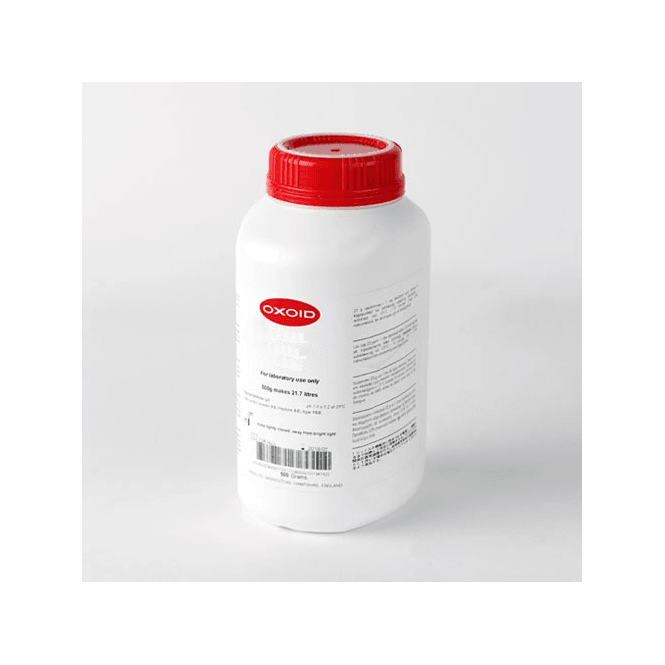Thermo Scientific™ Oxoid™ Sorbitol MacConkey Agar (SMAC) with BCIG (Dehydrated)
Catalog No :
CAS Number :
Brand :
In Stock
Specifications:
| Application | Microbiology | ||
| Storage Temperature | Room Temperature | ||
| Product Type | Culture Medium | Forms | Powder |
| Product Brand | Thermo Fisher Scientific™ | ||
| Product Grade | Microbiology grade | ||
The Thermo Scientific™ Oxoid™ Sorbitol MacConkey Agar (SMAC) with BCIG is a selective and differential culture medium specifically designed for the detection and differentiation of Escherichia coli O157. This advanced formulation incorporates 5-bromo-4-chloro-3-indolyl-β-D-glucuronide (BCIG), which adds an enzymatic differentiation layer by targeting β-glucuronidase activity, a feature absent in most E. coli O157 strains.
This dual-screening mechanism—failure to ferment sorbitol and lack of β-glucuronidase activity—improves diagnostic accuracy and reduces false positives. It is particularly suited for detecting E. coli O157 in food, clinical, and environmental microbiology.
Key Features
1. Enhanced Selectivity
- Selective for Escherichia coli O157:
- Utilizes sorbitol and selective agents to suppress non-target organisms while allowing the growth of E. coli O157.
2. Differential Capabilities
- Two Screening Mechanisms:
- Sorbitol fermentation:
- Non-fermenting E. coli O157 appears as straw-colored colonies.
- Sorbitol-fermenting organisms appear pink.
- β-Glucuronidase Activity:
- E. coli O157 lacks β-glucuronidase and remains straw-colored.
- Other β-glucuronidase-positive E. coli appear blue-green.
- Sorbitol fermentation:
3. Improved Accuracy
- Reduces false-positive suspect colonies by 36% in meat samples compared to traditional SMAC formulations.
4. Versatile Applications
- Suitable for detecting E. coli O157 in:
- Meats (beef, goat, lamb, venison).
- Dairy products, vegetables, and fruit juices.
- Water and other environmental samples.
5. Food and Public Health Safety
- Designed to detect Escherichia coli O157, a major pathogen associated with:
- Hemorrhagic colitis (HC).
- Hemolytic uremic syndrome (HUS).
Composition and Mechanism
The medium includes:
- Sorbitol: Differentiates lactose- and non-lactose fermenters.
- BCIG: Substrate for β-glucuronidase enzyme activity, yielding distinct colony colors based on enzymatic cleavage.
| Colony Appearance | Result |
|---|---|
| Straw-colored colonies | Non-sorbitol-fermenting, β-glucuronidase-negative E. coli O157. |
| Blue/Green colonies | β-Glucuronidase-positive E. coli or other organisms. |
Applications
1. Food Microbiology
- Screening meats, dairy, and produce for E. coli O157 contamination.
- Detects pathogens in processed and raw food products.
2. Clinical Diagnostics
- Identification of E. coli O157from stool samples of patients with suspected foodborne illnesses or HUS.
3. Environmental Monitoring
- Tests for E. coli O157 contamination in water supplies, wastewater, and environmental samples.
Advantages
1. Dual Differentiation
- Combines sorbitol fermentation and β-glucuronidase activity for more reliable E. coli O157 detection.
2. High Sensitivity
- Reduces false positives compared to traditional SMAC formulations.
3. Broad Applicability
- Ideal for food safety testing, clinical diagnostics, and environmental investigations.
4. Easy-to-Interpret Results
- Distinct colony coloration allows quick and accurate differentiation.
Preparation and Use
- Preparation:
- Rehydrate the dehydrated medium as per manufacturer instructions.
- Autoclave and pour into sterile Petri dishes.
- Inoculation:
- Streak the test sample (e.g., food, stool, or water) onto the prepared plates.
- Incubation:
- Incubate at 35–37°C for 18–24 hours under aerobic conditions.
- Interpretation:
- Identify colonies based on color and appearance:
- Straw-colored colonies: E. coli O157 (non-sorbitol fermenting, β-glucuronidase-negative).
- Blue/Green colonies: Other E. coli (β-glucuronidase-positive).
- Identify colonies based on color and appearance:
Advantages Over Standard SMAC
| Feature | Standard SMAC | SMAC with BCIG |
|---|---|---|
| Differentiation Mechanism | Sorbitol fermentation only | Sorbitol fermentation + β-glucuronidase activity |
| False-Positive Reduction | Moderate | Reduces false suspects by 36% |
| Colony Appearance | Colorless vs. pink colonies | Straw vs. blue/green colonies |
Why Choose SMAC with BCIG?
- Dual Screening: Offers superior accuracy for detecting E. coli O157.
- Improved Efficiency: Reduces workload by minimizing false positives.
- Enhanced Public Safety: Critical for ensuring food and water safety and preventing outbreaks.
The Thermo Scientific™ Oxoid™ Sorbitol MacConkey Agar with BCIG is an essential tool for food safety testing, clinical diagnostics, and environmental monitoring, providing enhanced specificity and reliability for detecting E. coli O157.
Composition of Thermo Scientific™ Oxoid™ Sorbitol MacConkey Agar (SMAC) with BCIG
The typical formula per liter of prepared medium is as follows:
| Component | Amount (g/L) | Purpose |
|---|---|---|
| Peptone | 20.0 | Provides essential nutrients (nitrogen and carbon) for bacterial growth. |
| Sorbitol | 10.0 | Differentiates sorbitol-fermenting organisms (e.g., other E. coli) from non-sorbitol fermenters (E. coli O157). |
| Bile Salts No. 3 | 1.5 | Selectively inhibits Gram-positive bacteria, allowing selective growth of Gram-negative bacteria. |
| Sodium Chloride | 5.0 | Maintains osmotic balance for bacterial growth. |
| Neutral Red | 0.03 | pH indicator: detects acid production during sorbitol fermentation. |
| Crystal Violet | 0.001 | Suppresses growth of Gram-positive organisms. |
| Agar | 15.0 | Solidifying agent, providing a stable medium for colony development. |
| 5-bromo-4-chloro-3-indolyl-β-D-glucuronide (BCIG) | 0.1 | Detects β-glucuronidase activity, producing a blue-green coloration in positive organisms. |
| pH | 7.1 ± 0.2 @ 25°C | Provides an optimal environment for bacterial growth and differentiation. |




 0
0
